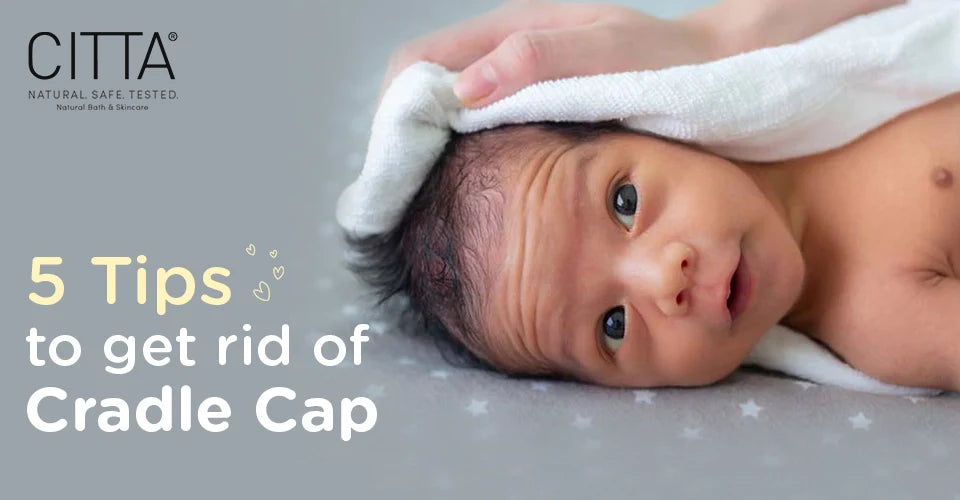5 Tips to get rid of Cradle Cap

Cradle cap is a common skin condition in babies, yet many parents can feel worried when their little one is affected by it. It is the common name for Seborrheic Dermatitis of the scalp in infants. In simpler terms, it is the baby version of dandruff. Cradle cap causes their scalp to develop yellow or white crusty patches. The patches or flakes can be oily or dry. Although it is mostly limited to the scalp, it can also affect the baby’s face, nappy area, and folds of the skin. Babies are usually affected by cradle cap in the first year of their life, most commonly around 2-4 months of age. The flaky scales look the same on all skin tones, but the skin under the scales can look different for various skin tones.
Cradle cap is not a painful condition and usually clears up on its own within a few weeks or months. It does not cause any itching or discomfort to your baby, so you need not worry too much. The cause of cradle caps in babies is not clear yet. Doctors think it might be linked to excessive sebum production by the oil glands. A type of yeast found on the skin, called Malassezia, may also have a role to play in the development of cradle caps in your baby.
Although it is not medically necessary to get rid of the cradle cap, there are a few things you can do if you want to remove it. However, you must keep in mind that these are not scientifically proven methods, so the results could be temporary. You should also remember to be gentle with your little one’s skin in all situations. Here are 5 tips to get rid of cradle cap:
Use a brush to remove the scales from your baby’s scalp
Use a gentle hair brush or toothbrush with soft bristles to loosen the flakes on your baby's hair and brush them off. Be careful to not scrape too hard at your baby’s scalp, it can be irritated easily. You can use brushes specially made for this purpose and gently brush your baby’s scalp once a day. You can do this with both wet and dry hair. If you notice any signs of redness or irritation, discontinue or reduce the number of times you brush your baby’s scalp.
Wash your baby’s hair and scalp with a gentle shampoo
Maintaining good hair hygiene can help prevent hair conditions like dry scalp, itchy scalp, and cradle cap. Washing your baby’s hair and scalp with a gentle shampoo can also help to soften the scales and temporarily remove the cradle cap scales from their scalp. Remember to use a shampoo that is free of harsh chemicals like parabens, sulfates, silicones, mineral oils, allergens, and toxins, since these chemicals can irritate your baby’s scalp. CITTA Baby Shampoo is natural, tear-free, and toxin-free – a great option for your baby. It is infused with Coconut oil, Almond oil, Olive oil, and Oats which help to hydrate and soften the cradle cap scales. They nourish your baby’s scalp and promote healthy hair growth. The gentle formulation also maintains the optimum pH balance of the scalp.
Related Products
Hydrate your baby’s scalp
As mentioned previously, hydrating your baby’s scalp with natural oil can help to loosen the cradle cap scales, making it easier to remove them. Choose a natural, fragrance-free, nourishing oil such as Coconut oil or Almond oil, or a mix of 12 nourishing natural oils like CITTA’s Baby Massage Oil, and gently massage your baby’s scalp with a small quantity of oil. Be careful around the soft spot on your baby’s head. Leave the oil to absorb for around 15 minutes and then wash it out with a gentle shampoo.
Apply dermatologist-prescribed ointments or creams
If your baby’s cradle cap does not go away in a few weeks, your doctor may prescribe certain anti-fungal or zinc creams. Applying them as directed can help you get rid of the cradle cap.
Seek medical attention if the cradle cap gets infected or causes discomfort
If your baby’s cradle cap gets infected or spreads to other parts of the body, you should seek medical attention.
Cradle cap is a common condition in babies, and is usually harmless. You can try the above remedies at home for cradle cap removal, but always remember to be gentle on your baby’s skin. Only use safe, natural products that are free of harsh chemicals and gentle on your baby’s skin. Seek medical help if the rash causes discomfort.
-
Is Sunscreen Really Good for Kids? What Every P...
Introduction Children's skin is delicate. Their skin is about 30% thinner than adult skin, which makes it more vulnerable to the sun in India. Yet, many parents think sunscreen for...
Read moreIs Sunscreen Really Good for Kids? What Every Parent Should Know
Introduction Children's skin is delicate. Their skin is about 30% thinner than adult skin, which makes it more vulnerable to the sun in India. Yet, many parents think sunscreen for kids is an extra burden instead of considering it a daily essential. Sun protection is absolutely necessary, yet it falls to the bottom of parenting priorities. Now, it is indeed important to explore the following questions: Is sunscreen really necessary and safe for our little ones? Why Kids Need Sunscreen More Than Adults Children’s skin needs extra protection than adults. Because their skin is much thinner, it absorbs UV radiation more readily, leading to immediate and long-term damage. Children often seem to spend their hours on playground breaks, school sports, or maybe a family outing, which all happen under significant sun exposure. According to research, during childhood years, substantial sun damage occurs. As per the Skin Cancer Foundation, before age 20, five severe sunburns increase melanoma risk by 80%. Therefore, early protection is about preventing temporary sunburns as well as safeguarding against future issues like premature aging, hyperpigmentation, and more serious conditions. What Makes a Sunscreen Kid-Friendly? All the sunscreens we see contain different components, particularly when it comes to children's sensitive skin. The best sunscreen for kids offers: These broad-spectrum covers come with both UVA and UVB protective factors. High SPF ratings, such as SPF 70 sunscreen, provide the best protection. Sunscreen, holding a PA++++ rating, provides intense protection in India's hot and humid conditions Formulations that have zero harmful chemicals like oxybenzone, parabens, and others. Unscented, gentle formulas that won’t irritate sensitive skin Try CITTA Protecting Sunscreen SPF 70 – specially formulated for baby-soft, sensitive skin. What to Look for in a Baby Sunscreen Lotion Things parents should prioritize while buying a baby sunscreen lotion Products that have gone through extensive dermatological testing Tear-free formulations that do not trouble the eyes Water-resistance properties are included, especially when kids are sweating or swimming The product is lightweight and has non-greasy textures that kids will not resist wearing All these features ensure your child will receive the best protection from the sun with no discomfort, which will eventually make the daily application much easier for everyone involved. When and How to Apply Sunscreen on Kids Timing and technique are both extremely important to know when it comes to effective sun protection. Apply sunscreen for kids 20 minutes prior to going out as it gives the product some time to form a protective barrier on the skin. While applying, we have to be really generous, as most parents use too little. Apply all the exposed areas, including often forgotten ones: ears, neck, and feet. Putting an alarm on in your phone for the reapplication of your preferred sunscreen every two hours is essential, especially after swimming or heavy perspiration. Do not forget to make sunscreen a year-round habit. It is just not for sunny days, but it is necessary to apply sunscreen on cloudy days too. Harmful UV rays penetrate cloud cover, reaching your child's skin. Common Myths About Sunscreen for Kids Let's go through some common misconceptions: ❌ "Children don't need sunscreen if they stay in the shade." Reality: Reflection of UV radiation from surfaces like sand, water, and concrete reaches the skin even in shaded areas. ❌ "Sunscreen is only necessary during summer or beach outings." Reality: UV radiation affects skin year-round, no matter what the temperature is. ❌ "Dark-skinned children have natural protection." Reality: It is true that melanin offers some protection, but it is essential to have dedicated sun protection for children. ✅ Truth: Every child benefits from daily sun protection irrespective of the nature of the weather, location, or skin tone. Also Read: Sunscreen for Kids: Debunking Myths and Determining the Right Age to Start The CITTA Advantage: Why Parents Trust Our SPF 70 Sunscreen When choosing the best sunscreen for kids, parents trust in CITTA's SPF 70 protection. Let’s take you through what sets it apart: Specifically formulated to protect children's delicate skin from the sun Doesn't leave a chalky white residue that kids will not like Contains no harsh chemicals that might cause sensitivity Works effectively and efficiently across all skin types and tones Pediatric skin specialists do recommend this to parents. As per parents’ honest reviews, children prefer CITTA Protecting Sunscreen SPF 70, its pleasant, non-sticky feel, which is less of a battle and has turned into a routine of protection for their children’s skin. Final Thoughts Sun protection isn't just about preventing today's sunburn, but it is also an investment towards your child's lifelong skin health. When applying baby sunscreen becomes a habit of daily skincare routine as brushing teeth, it establishes a discipline, a healthy habit that will benefit them for decades. With the right child-safe sunscreen in India, children get the freedom to enjoy outdoor activities while you are also ensuring that their precious skin is protected. Remember: healthy skin begins with early protection, and the responsibility of keeping the skin protected begins with you. Also Read: How to Choose the Best Sunscreen for Dry Skin FAQ Section: 1. Is sunscreen safe for babies and toddlers? Yes, for children over 6 months, it is absolutely okay to apply sunscreen, which is a mineral-based formula with zinc oxide for sensitive baby skin. For younger babies, rely on shade and be picky about clothing instead. 2. Can I use adult sunscreen on my child? It's better to use dedicated baby sunscreen products as children's skin is more sensitive. Therefore, kid-friendly formulas have fewer irritating ingredients. 3. How often should I reapply sunscreen on my child? Every 2 hours during sun exposure, and repeat the application more frequently (every 80 minutes). Do the same while swimming or sweating heavily. 4. Is SPF 70 sunscreen too much for kids? No, SPF 70 sunscreen provides appropriate protection for children and is perfect for dealing with India's climate. Most parents are not aware of the right quantity of the product to use, so higher SPF offers better safety. 5. Can sunscreen cause skin irritation in kids? Some children may be sensitive to certain ingredients. Before picking a sunscreen, perform a patch test first. Choose mineral sunscreens for sensitive skin and consult a doctor if irritation occurs. Also Read: The Best Sunscreen for Newborn: Protecting Your Baby’s Delicate Skin
Read More -
How to Take Care of Your Baby During Summer in ...
Summer is almost here and your newborn baby needs a little extra care this hot season! Keep reading for some essential summer newborn care tips to keep your little one...
Read moreHow to Take Care of Your Baby During Summer in India: Essential Tips for Hot Weather
Summer is almost here and your newborn baby needs a little extra care this hot season! Keep reading for some essential summer newborn care tips to keep your little one safe and comfortable.
Read More









